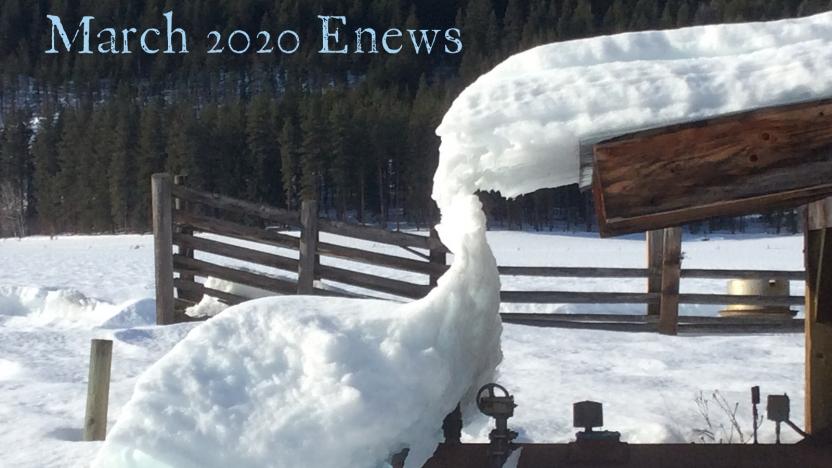
March Enews
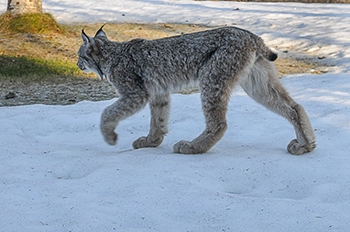
March First Tuesday: Endangered - The Status of Lynx in Washington State
Tuesday, March 3rd, 7pm – 8pm
Venue: Winthrop Barn, Free, no RSVP required
Following the tracks of the February First Tuesday by Scott and Amy Fitkin and our Snow’s Biome Conservation Course, come hear Washington State University Associate Professor of Mammal Spatial Ecology and Conservation Dan Thornton. Professor Thornton will present on his work in the Okanogan-Wenatchee National Forest using a camera trapping array to document the current lynx distribution in Washington State. Through an intense and expansive effort involving Washington State University, agencies, NGOs, and citizen scientists, a picture of lynx status in the state is beginning to emerge. In addition to discussing the details of past and current camera work, the talk will touch on the larger picture for lynx research and conservation in the region.

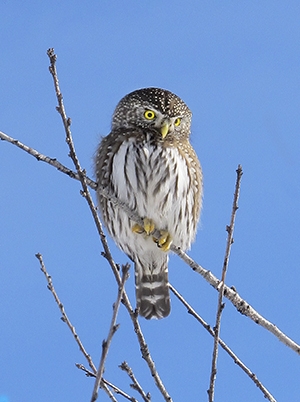
Learn with Us!
As spring starts springing, we're offering some excellent opportunities to get outside and learn with us! To register for any of these events, email Daniel or call us at 509-996-2870.
- March 2nd: Snow Science - Session #2 of our annual Conservation Course - local snow science expert Brad Sawtell will help us learn about what snow is, how it forms, and in what ways it shapes our landscapes.You can sign up to take all three remaining Conservation Course classes or take only one!
- March 3rd: First Tuesday - Endangered - The Status of Lynx in Washington State - join Professor Dan Thornton for a look at lynx.
- March 9th: Humans and Winter - Session #3 of our annual Conservation Course - we have partnered with the Methow Valley Interpretive Center and the Shafer Museum to share stories of humans of the Methow Valley and their winter time activities.
- March 10th: Big Valley Owling Adventure - a night walk listening for owls!
- March 14th: Ties to the Land: Succession Planning for Family Farms, Ranches and Working Forests - a workshop of presentations and practical exercises to explore transferring a farm, ranch or working forest from one generation to the next.
- March 16th: Living Snow- Session #4 of our annual Conservation Course - Dr. Robin Kodner, Associate Professor of biology at Western Washington University explores the microbiome of snow.
- March 19th: Spring Equinox Walk - a guided 2-3 mile walk on a conserved property to celebrate the coming of longer, warmer days!
- March 24th: Share – Your – Knowledge Series: Connecting to the Land with your Senses - join local natural sensory expert Kyle Northcott as he shares his knowledge and guides a structured mindfulness outing.
- March 28th: The Winter's Tale - A Wenatchi Tribal documentary film followed by Q&A with Randy Lewis and the film-makers. Hosted by the Methow Valley Interpretive Center and co-sponsored by Methow Arts Alliance, The Methow Conservancy, and the Methow Valley Citizens Council.

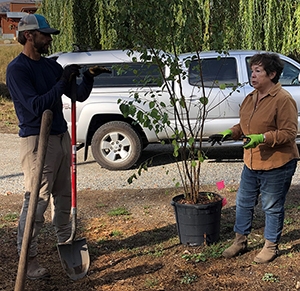
Volunteer with Us!
Our field season full of volunteer activities is just emerging!
- March 17th - Prune till Noon at Homestream Park: Help us prune the native vegetation we planted last fall at Homestream Park. Master Gardener and certified arborist Theresa Miller will lead a mini class on how to properly prune and then we will head out and prune all of the restoration plantings till we hit noon. For more details and to sign up visit our Volunteer Methow link.

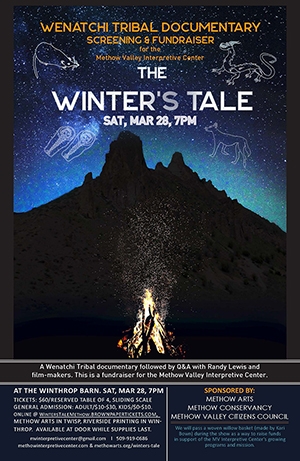
Special Event: The Winter's Tale - A Wenatchi Tribal documentary film followed by Q&A with Randy Lewis and the film-makers. Hosted by the Methow Valley Interpretive Center.
March 28th, 7pm
Location: The Winthrop Barn
Tickets: available on Brown Paper Tickets, or at Methow Arts and Riverside Printing.
The Methow Valley Interpretive Center presents the Methow Valley Premiere of “The Winter’s Tale” - A Wenatchi Tribal documentary followed by Q&A with Randy Lewis and the film-makers. We're excited to be a co-sponsor of this special event, along with Methow Arts Alliance and the Methow Valley Citizens Council.
This film takes its name from a time-honored practice when, in the deep of winter, a tribal elder would gather the young people around and begin to tell a story, a story about the land, about the powers of the animals roaming through it and about the relationship of the people to it all. These stories would unfold over not just hours, but over a period of days, delivered with a sense of poetry, a cadence that captivated the young listeners and imprinted on them deeply, connecting them to the land and to their own heritage in ways that would remain with them their entire lives, and ultimately would be told again in the deep of winter to the generations not yet born.
These stories exist still today and it is the purpose of this project to capture them in a form that can captivate the modern young mind. Through Native storyteller Randy Lewis it is possible still to connect our youth to the lands, to imbue them with a sense of awe, wonder and respect. This project seeks to endow students with the skills to become modern storytellers and to deliver those stories through the channels of today – in classrooms, through TVs and YouTube – all while preserving these stories forever.
The Winter’s Tale is a directed film study program through the Icicle Creek Center for the Arts.
This special event is a fundraiser for the Methow Valley Interpretive Center. Ticket options include: $60/reserved table of 4; Individual Tickets (sliding scale): $10, $20, $30, or Student Tickets (sliding scale): $0, $10. Tickets available on Brown Paper Tickets, or at Methow Arts and Riverside Printing. (Free tickets to Cove and Room One and volunteers are available).

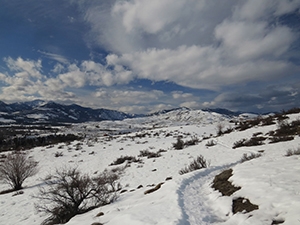
Spring Coming to Meadowlark Natural Area
With the melting of snow also comes the green-up of the western slopes that make up the 139-acre property we call the Meadowlark Natural Area in Winthrop. Our intention has been to protect the scenic backdrop to the Town of Winthrop and provide public access WHILE protecting its flora and fauna. Upon consultation with WDFW, we learned how critical this particular property is for mule deer both as winter range and during green-up. Green-up (the emergence of green vegetation rich in nutrients and calories) happens in early spring when many of the deer are running out of fat reserves and does are likely to be pregnant. Being able to access the highest quality of forage during this time-frame is important to our local herd.
For this reason, there will be a seasonal closure on the new trail system for the month of March. This will happen every year during this time. Methow Conservancy staff has taken the time to have personal front-porch discussions with many of the neighbors in close proximity to the Meadowlark Natural Area, in addition to the distribution of flyers and emails, to explain the reasons behind this closure.
We look forward to re-opening the trails on April 1stand having an official opening of the property during this coming summer. Keep your eyes open for stewardship volunteer opportunities that will be offered on Meadowlark projects. Questions? Email Heide.

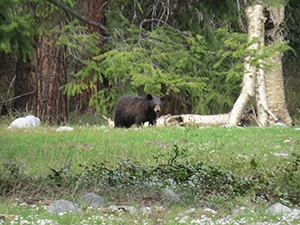
Starting Toward Bear Smart
We’re excited to be partnering with Wastewise Methow, the Washington Department of Fish and Wildlife, and Defenders of Wildlife, in an effort aimed at one day making the entire Methow Valley “Bear Smart” when it comes to our trash receptacles. After a very active year in 2019 for our local black bears and garbage cans and dumpsters in several areas of the Valley, this collaboration formed last fall to discuss the tangible steps we can take as a community to keep black bears out of our garbage cans, which otherwise often ends in the bear being euthanized.
“Unfortunately, a fed bear is almost always a “dead bear” said local WDFW biologist Scott Fitkin, who is excited to be part of the collaboration. “Keeping bears out of our garbage cans, compost piles and bird feeders is a simple way we all can co-exist with the wildlife we share our Valley with” said Fitkin.
Over the next few weeks, Wastewise Methow will begin testing approximately 10 bear-resistant cans in the Mazama area from two different manufacturers. “It is important that we understand which cans work best with our trucks and for our customers” said Casey Bouchard, who operates Wastewise Methow. “We’re happy to be working with great partners in our community to address an issue that consumes a lot of time and energy."
“Thanks to a generous donor, the Methow Conservancy was in a position to help purchase the initial test cans” said Executive Director Jason Paulsen. “This early financial support has helped our community to leverage additional support from project partner Defenders of Wildlife, and our collaborative is working to identify future funding sources that can be used to help off-set the initial capital costs of these cans, which cost approximately $250 a piece” added Paulsen.
Once the test period is complete, the goal of the project will be to equip all customers in the Mazama area and along Wolf Creek Road with the bear-resistant cans. “Ultimately we would like to see these bear-resistant cans and dumpster lids deployed throughout the valley” added Tom Bihn, a local resident engaged in the project.
Watch for updates in the coming months as we hope to see more bear-resistant cans deployed as part of the first phase of this project in time for our bear “neighbors” to emerge from hibernation this spring.


Be Water Smart: Smart-Meter Sign-Up
The Methow Watershed Council (MWC) has initiated a voluntary water metering program to help Council members understand how much water residents use and how demand is likely to change over time. The MWC has a pilot metering program underway and is now creating a list of landowners who are interested in having meters installed as part of a larger program that will generate a more robust data set. The MWC will use that list to demonstrate support and generate funding for the program. Click HERE to email us if you are interested in participating or would like to learn more. The meters upload data directly to MWC’s portal and will work any place there is a Verizon cell phone signal (whether or not the owner is a Verizon customer). Owners can log in to a secure portal to monitor their own use and even detect leaks. To learn more about the MWC’s water accounting project, click here.


From the Ag Desk:
By Alyssa Jumars, Agricultural Coordinator
In late February, we hosted a Direct Marketing Strategies workshop for small farms. Laura Raymond, program director for the WSDA’s Regional Markets Program, gave an engaging presentation about consumer trends and shared creative strategies for reaching target markets. We learned that words really matter… Consumers are looking for food that is healthy, unique, environmentally friendly, and authentic -- and it’s important for farmers to understand how to communicate their products’ attributes.
We want to hear from YOU. If you buy locally-raised food in the Methow Valley, please take this 2-minute survey and let us know what motivates you!

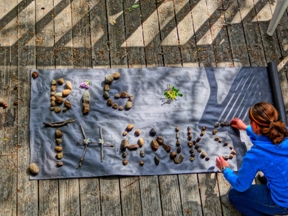
Thank You!
A big thanks to all who wrote, emailed or called your state Senator and Representatives to voice support for conservation legislation this session. Here’s a quick update:
Agricultural water transfers: Several different bills had language that would have prohibited the transfer of agricultural irrigation water out of the Methow Valley and other watersheds. The number of responses from our Valley in such a short time made a big impression in Olympia! Despite the great show of local support and tremendous help from our 12th District legislators, none of the legislation was successful in halting these transfers.
On Monday, the Senate’s proposed Operating Budget did include a proviso directing the Department of Ecology to study water transfers and other aspects of the state’s water trust and water banking programs. We thank Senator Brad Hawkins for working to secure funding for this study group.
Suction Dredge Mining Reform - ESHB 1261, a Bill to regulate suction dredge mining in critical salmon habitat, is now in the WA Senate Rules Committee where it awaits being “pulled” to the WA Senate floor for a vote. Please contact your Senator and ask them to support Senate leadership in bringing ESHB 1261 to the floor for a vote next week!

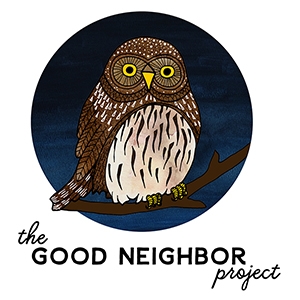
We're Looking for Landowners!
Last spring the Methow Conservancy embarked on an exciting new pilot project called the Good Neighbor Project. Over the course of the spring we worked with 23 incredible small-acreage landowners to be good stewards of their property (and good neighbors). We started the project because we believe small-acreage landowners can have a big impact on the land and on the community’s conservation culture.
We learned a lot through the pilot phase last year and now we are ready to offer the Good Neighbor Project to 20-25 new small-acreage landowners. We can guarantee that you will learn a lot being part of this project and meet some great conservation minded people in the process! Participation is free, we only ask for your time and energy.
We will be accepting applications for the project in the month of March. To apply you need to have general availability this April and May and send your name, email, and property address to Daniel. Successful applicants will be emailed with further instructions. Any questions about this project can be directed to Daniel or call us at 509-996-2870.

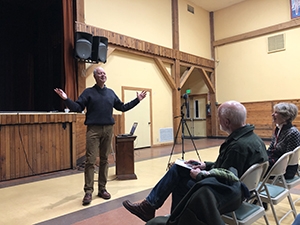
Conservation Course Snow’s Biome Week One Recap
Dr. Erick Greene of the University of Montana, started our 2020 Conservation Course off with a bang (or a “seet!” a “wah” and a “wek”) with his fascinating presentation on distant early warning systems in the Forest. He brought to life the dynamic communication network that exists in forests, including findings from his research (some of which happened right here in the Methow Valley during winter) on chickadee and nuthatch warning calls in response to different levels of predator threat.
We learned that many songbirds and squirrels have a similar “Seet” alarm call that alert other animals to high danger – a bird of prey in flight. When animals hear this call, they understand the level of threat it represents. Another type of call, the mobbing call, can alert other birds to the presence of a perched raptor. Other birds in the area can then fly in to mob the threat, chasing predators out of the area.
In order to conduct controlled experiments, Dr. Greene and his colleagues developed “robo raptors” to test the response of songbirds to the presence of different predators. Depending on the species of raptor, songbirds expressed different alarm calls, triggering a forest-wide response. Information travels fast in the forest – often faster than a flying raptor! And the language can be universal. Not only do birds and squirrels share a similar “Seet” call, but some caterpillars can imitate the seet alarm calls of their predators (birds) by whistling through tiny holes on the side of their body, effectively scaring away the danger. So the next time you’re out in the forest, have a listen – the birds and the squirrels might be telling you something!
Up next in our 2020 Conservation Course? Join us to learn about snow from local snow science expert Brad Sawtell on Monday, March 2nd 6-8 pm at the Winthrop Barn! Registration is required and the cost is $30.

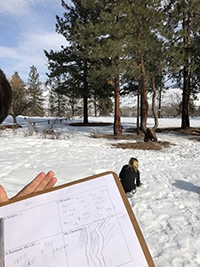
Schoolyard Science Update: Nature Journaling!
During our most recent Schoolyard Science outing, students had the opportunity to put their powers of observation and expression to the test! Inside the classroom, we observed species of birds and took turns describing them, writing down what we notice, and sharing drawings with our partners who had to guess what bird we saw. Outside, we paid close attention to a single tree, asking questions, making connections, noticing many details, and drawing the tree. Fourth graders are great observers!


Make a Match: Donate in March and Every Dollar Doubles!
March is the final month of our fiscal year. While many of you will be eagerly awaiting basketball's March Madness, we also celebrate March “Matchness,” our super-exciting, drive-to-the-hoop bonus time when every dollar donated to our Annual Operating Fund is matched dollar for dollar up to $30,000 total until March 31st. It's always thrilling!
We’re focused specifically on encouraging new members and those who haven’t yet renewed their membership in the last 12 months. So, if you have already supported our conservation efforts in the past 12 months, thank you! You can still help us play great offense by sharing this opportunity with others you know who love the Methow Valley. If you haven’t yet supported our conservation efforts this fiscal year (April 1, 2019 – March 31, 2020) and you can help with a few “hoops,” simply click here and put your gift in our basket today! We’d love to count you on team Methow Conservancy.

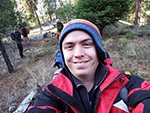
Nature Observations with Trevin Leon
Winthrop resident Trevin Leon has inspired us once more with his keen eye and photography skills. Trevin sent us this photo of a mule deer buck taken in town near the Pine Near RV Park. He said "pretty majestic-looking." We agree.
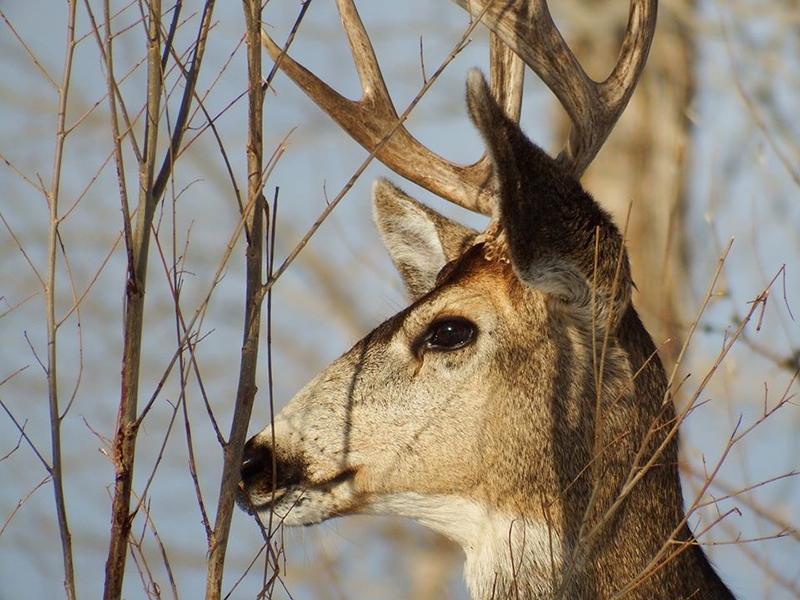

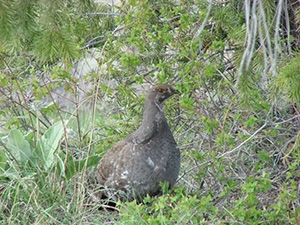
Nature's Notes: The Dusky Grouse
by Julie Grialou, Conservation Biologist
I’m always curious about animals that “buck the trend” with behavior that is not typical. One of those species is the dusky grouse, a common species in our watershed. When we think of fall migration, we think of birds moving south or to lower elevations. However, the dusky grouse typically moves UPWARDS in elevation in the fall and winters in dense, coniferous forests, where it feeds almost exclusively on conifer needles. The birds find an abundant source of food here, as there is little competition, and also live relatively free of predators during this time, as most predators follow larger game animals to lower elevations. Some behaviors dusky grouse employ to keep warm and conserve energy during the winter include sunning themselves, walking uphill, and choosing sheltered microsites for roosting (usually large tree branches next to large tree trunks that absorb and emit heat from the sun). They will occasionally roost within the snowpack, particularly after big snowstorms. They enter the snowpack by either diving into it or walking into it. Watching a bird dive into the snowpack would be quite a site!

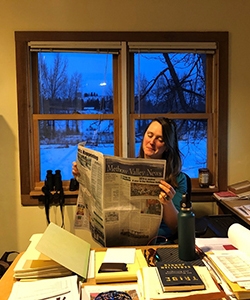
March Reading List
We thought you might be interested in seeing what we’ve been reading lately. Editor’s note: These articles do not represent the beliefs or opinions of the Methow Conservancy or its staff. We offer them purely as a means of sparking discussion.
UW News: Thinning Prescribed Burns Protected Forests During the Massive Carlton Complex Wildfire - The Carlton Complex was the largest contiguous fire in state history. A new study authored by University of Washington and Forest Service researchers including the Methow’s very own Susan Prichard investigated whether prescribed burning and thinning made a difference in tree survival rates after the Carlton Complex. What they found is highly relevant to our community’s ongoing efforts to be fire wise and prepared.
Crosscut: Human Elements - Climbing for the Origins of Life - Our fourth and final conservation course speaker Robin Kodner is a Professor of Biology at Western Washington University who studies specialized forms of algae that survive and thrive in snow and ice. This short film made for Crosscut presents a snapshot into Robin’s research and what it takes for her to gather data. For the whole picture join us on Monday, March 16th, at 6pm in the Winthrop Barn for Robin’s Conservation Course presentation. Cost of the class is $30, to sign up email Daniel.
Seattle Times: Washington’s Rivers, Salmon and Orcas Need Protection from Canadian Mines - A Canadian mining company has applied to mine in the headwaters of the Skagit River. This opinion piece written by Jay Julius of the Lummi Nation, Mitch Friedman of Conservation Northwest, and Pete Knutson of Loki Fish Company lays out a strong argument for why Washington lawmakers should address the damage caused by Canadian mining companies to Washington’s watersheds.
Audubon Magazine: Harriet Tubman, an Unsung Naturalist, Used Owl Calls as a Signal on the Underground Railroad - After leading an owling outing last week at Big Valley, I found this article humbling and Harriet’s abilities as a tactical naturalist inspiring.
The New Yorker: Survivors Guilt in the Mountains - This interesting long read takes a look at North Face’s professional mountaineering scene through the lens of their differing mentalities on climbing deaths and survivors guilt.

News from Other Organizations
- Okanogan Highlands Lavender Farm: Birds and Bees – Saturday, May 23rd, 8am – 6:30pm, @114 Barker Mt. Road, Tonasket, WA 9855, Cost/ $30, registration is required. The Okanogan Highlands Lavender Farm is hosting a full day education celebration of the importance of pollinators. To get more information and register email: michelle@okanoganhighlandslavenderfarm.com
If you would like to share news from another organization, please email us by the 25th of the month.

We'll leave you with this spring teaser. Yes, we are still a few weeks away from wildflowers, but it reminds us that every season in this Valley is amazing!
